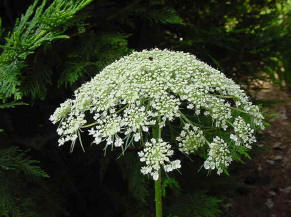I believe carrots are one of the most intriguing vegetables to have in your garden...you watch the greens grow but never see the actual vegetable until harvest day. It's always a bit of a surprise.
|

Queen Anne's Lace
Daucus carota
|
Carrots, Daucus carota sativa, is believe it or not, a descendant of Queen Anne's lace, the wild flower we commonly see. In a warm area (like ours last winter), if a carrot is not picked, it will produce tiny flat-topped white flowers in its second year similar to it's
relative. As a vegetable, the carrot is grown as an annual with its fine feathery green foliage on the top and it's delicious orange/yellow root. You can try harvesting the seeds from the flower to start new carrot plants or simply buy the seeds. Below is information and
helpful hints for growing carrots.
Carrots are cool-weather vegetables so are best grown in the spring and fall. They prefer loose, well-drained soil free of rocks and debris. In the early spring begin planting your carrots when the soil is 45°F. You can make successive plantings every three weeks until
the very hot weather arrives. In late summer or early fall plant another crop of carrots. They are fairly cold hardy and can tolerate cold weather and light frost. They can be protected from a hard freeze by a heavy mulch.
Sow the seeds thinly about ¼ inch deep and ½ inch apart. Carrot seeds are very small so exact spacing may be difficult to accomplish. Single rows should be spaced 1 - 1 ½ feet apart or plant double rows 6-12 inches apart and then a wider row to make access for care and
harvesting easier. An alternative to row planting is broadcast sowing where the seeds are sprinkled or spread randomly across the planting area. Carrot seedlings take two weeks or longer to come up. They often fail to emerge because the small seedlings cannot break through
soil that has become crusted and dry. Very, hot dry weather can also impede the germination. It is helpful to mix in some radish seeds when planting your carrots. The radish seeds are fast germinating and will break up the soil surface making it easier for the carrot seeds
to come up. The radish seeds provide the added benefit of marking your carrot rows while you are waiting for them to emerge. Once the carrots have germinated the radishes can be harvested.
When the carrot seedlings are about two inches tall thin them so they are 1-2 inches apart. If they are not too crowded you can wait and thin the plants when the largest roots are ready to eat, leaving the smaller ones to continue growing.
Carrots respond well to uniform soil moisture. Mulching will help retain the moisture and prevent the development of "green shoulders". Green shoulder occurs when the sun hits the top of the carrots turning them green and making the root bitter.
The carrot rust fly can also bother your carrots. The maggot stage eats along the outside of the carrot. Using a floating row cover or interplanting onions or garlic between your carrot rows can keep these flies at bay.
Carrots should be harvested when they reach the appropriate size given the cultivar you planted. The largest carrots will have the darkest greenest tops. To harvest your carrots it is helpful to soak the soil with water to make them easier to pull up. Grasp the greens
and pull gently with a slight twisting motion. The green top should be immediately cut off to help decrease moisture loss from the carrot, keeping it crisp. Topped carrots can be stored at 32°F up to 4-5 months with no significant loss of quality. There are many varieties
of carrots that can be grown from the miniature types that are 2 ½ - 3 inches long to the imperator types, like those you commonly see in the grocery store, up to 8 inches long.
Carrots may be a bit of a challenge to grow but certainly worth the effort. And don't forget to start thinking about other vegetables to include in your fall garden such as lettuce, broccoli, brussel sprouts, cauliflower, radishes and spinach. Happy Gardening!!!
Read other articles on growing herbs or vegetables